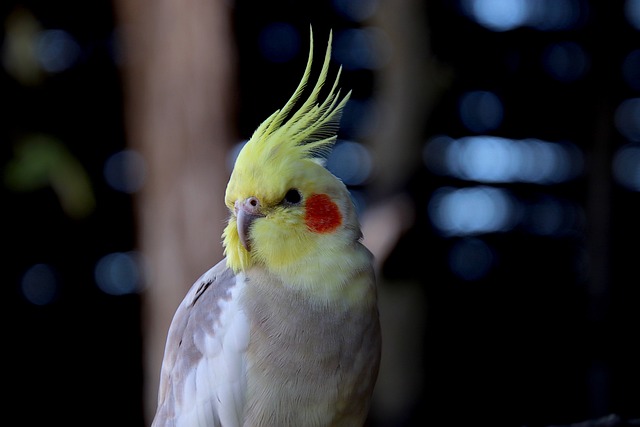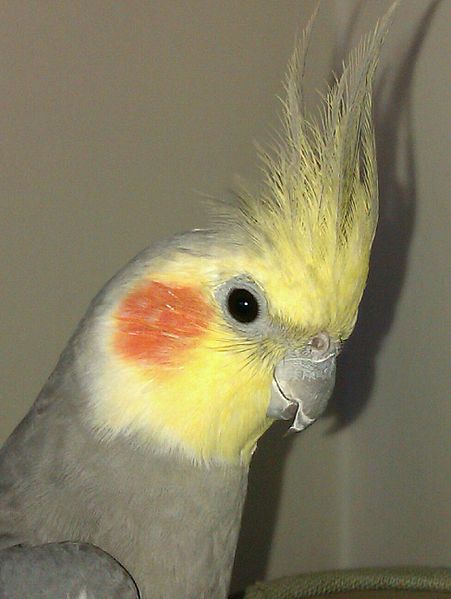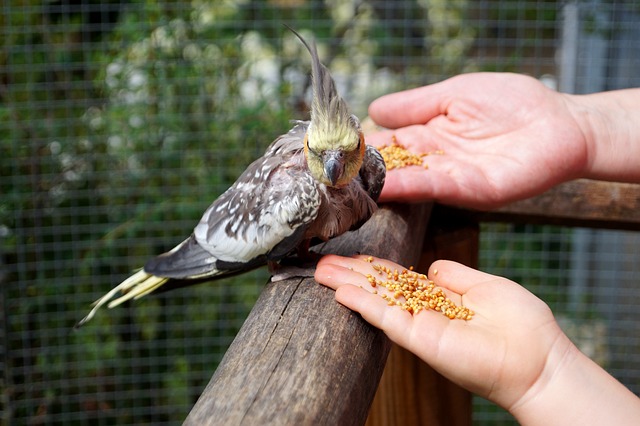The Cockatiel is also known as the Quarrion, the Weero, or by its scientific name, Nymphicus hollandicus. It is a bird native to Australia. The only members of their genus, Cockatiels are now biologically classified as the smallest of the Cacatuidae (Cockatoo) family.
The Cockatiel grows to about 13 inches in length, they are predominantly gray with the typical crest atop their heads. This crest is used to express their present disposition. When agitated or excited the crest will rise to vertical, lowers to a neutral position when they’re content, and will lay flat on their head when they’re angry or upset. The cockatiel has long tail feathers which make up half of its length.

The Cockatiel is native to the outback regions of inland Australia and tends to favor the Australian wetlands, scrublands, and bushlands.
While their plumage is mostly grey, they do have white flashes on the outer edges of their wings, and round orange cheek patches which tend to be brighter in males than in females. The males also typically have a yellow or white face.
There are about 15 primary mutations that result in a variety of colors. The result of these mutations is usually an exaggerated bald spot below the crest. In most mutations, the Cockatiel is sexually-dimorphic only in adulthood while both male and female young cockatiels display the dimorphic features typical of adult hens.
Generally, hens as well as immature birds of both genders display either barred, dotted or striped undersides of their tail feathers while cocks almost always display solid-colored undersides of their tail feathers. A row of clear colored spots can be found on every flight primary & secondary flight feathers of hens and young of both genders, but are usually not present in adult males.
Cockatiels are known to be noisy birds and are talented at making a variety of noises. The males more often than the females can learn to speak a few words. The more a cockatiel is able to bond with family members the happier and healthier it will be.

How long does a cockatiel live
Cockatiel lifespan varies quite a bit. Most birds live around 10 years; however, on a good diet and with good care, you can expect your bird to live up to 20 years, and there are some reports of birds living up to 25 years.
Bonding With Your Cockatiel
Bonding occurs when people care for, spend time with, play with and train a cockatiel. Training a cockatiel is also a very important part of owning them. Not only does it stimulate them mentally but it creates a bond between you and your bird.
Training also has the effect of teaching your cockatiel a few routines or expectations to make day-to-day care easier.
Among the common tricks first taught to a young bird and the step-up and step-down commands which make it easier to retrieve your cockatiel from its cage.
Basic care includes an appropriately sized caging environment, regular cleaning, 12 hours of quality sleep each night, fresh water, fruits and vegetables, a diet based on pellets, daily time and attention outside of their cage, and regular training.
Cockatiel Diet
Cockatiels can be picky about what they eat. When choosing a cockatiel, try to find one that already eats pellets. However, unfortunately, many breeders and pet shops feed their bird’s seed and not pellets. If you can’t find a bird that already eats pellets, at least find one that eats a variety of other foods (fruits, veggies, etc.). Not only will they be healthier for the varied diet, but they will probably be more accepting of you switching them to pellets – which you should do!

Cockatiels on a seed-based diet tend to have vitamin deficiencies and are often overweight; both problems can cause serious health problems. Cockatiels, being smaller birds with small beaks even for their size, usually prefer smaller-sized pellets and other foods.
Some birds have problems tackling larger pieces; once I switched my small female cockatiel to larger size pellets when I ran out of the smaller ones, I didn’t realize she couldn’t eat them (I saw her, as usual, by the food dish most of the time) until I noticed she’d lost quite a bit of weight! It wasn’t yet life-threatening (especially considering how overweight she was, to begin with…), but it could all too easily have been.
Try to keep a cockatiel’s diet as varied as possible; many different types of fruits, veggies, pasta, rice, and lots of other things should be included. Most cockatiels dislike citrus fruits, and most adore cooked corn (which shouldn’t be fed too much, because it’s mostly water and not all that nutritional).
Cockatiel Breeding
Cockatiel breeding season lasts from August through December, but they can breed year-round and often do so following a rainstorm. A cockatiel nest is typically found in hollow tree limbs or trunk holes, especially those located near water. A standard cockatiel clutch is 4 to 7 eggs, laid every other day, and hatching follows within 18-21 days. The juvenile takes on adult plumage at around 6 months.
